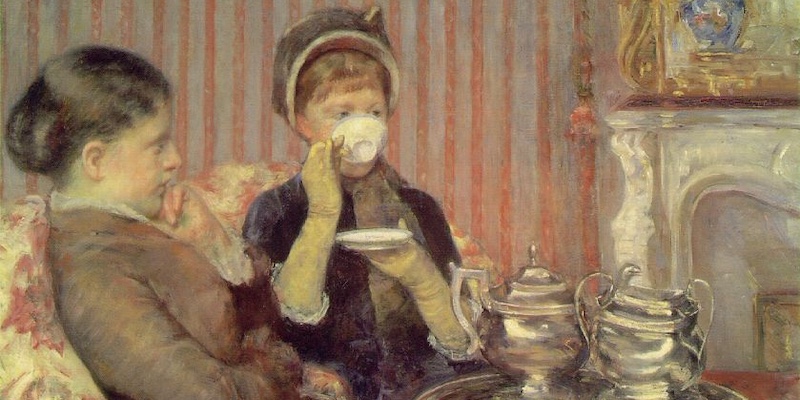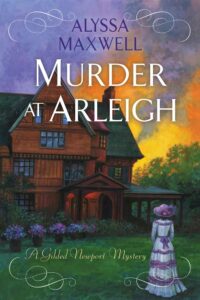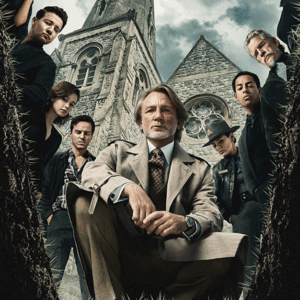When we consider what marriage was in the Gilded Age, we tend to think of it mainly as a business transaction that forged bonds between the families of the Four Hundred, that secured fortunes within carefully orchestrated dynasties. Marriages of convenience. In many cases, that’s exactly what it was. And many of these matches were made in Newport, RI.
Besides affording these wealthy families a break from the summer heat of New York City, Newport was fertile ground for marriage mart. The City by the Sea provided the Four Hundred with two invaluable opportunities. Because the grand mansions, or “cottages,” were located within a relatively small area, it was a place to showcase one’s wealth, and this was done extravagantly along the fashionable Bellevue Avenue. The Four Hundred strived to own the largest, most ornate and modern house, the most luxurious yacht, and spent thousands each year adorning their wives and daughters in the very latest House of Worth fashions. But equally important was the atmosphere of Newport, which was so much more relaxed than the City. Parties, picnics, theater events, and balls provided ample opportunity for parents – primarily mothers – to steer their adult children toward advantageous matches. Sometimes those matches were agreeable to said children; other times, mothers needed to employ more forceful means.
We see this with Gladys Russell in HBO’s The Gilded Age, when her mother insisted she marry the Duke of Buckingham. In many ways, this storyline mirrors Consuelo Vanderbilt’s marriage to the Duke of Marlborough, a prospect she resisted until her mom, Alva, wore her down. Consuelo was literally locked in her room at times; during the height of their tensions, Alva pretended to be seriously ill with a heart condition to prey on Consuelo’s sympathies. Consuelo finally consented to marry a man with whom she had nothing in common, a man admittedly marrying her only for her money, and who would continue to see his mistress. Predictably, they never became a happy or even a contented couple. Once Consuelo had produced the necessary heir and spare, she and the duke began to lead essentially separate lives. Consuelo made the most of her status as a duchess to bring about positive changes both locally, in the areas surrounding Blenheim Palace, and nationally, as she influenced Parliament to establish laws to help the poor. But her story isn’t unusual for the Dollar Princesses, as they were called. American girls with large doweries saved many of the great estates of Europe, but they were often looked down upon by the very families whose coffers they filled. But that was the bargain: money in exchange for the prestige of a title.
But not all Gilded Age marriages were as cut-and-dried. Consuelo’s cousin, Gertrude, married Harry Payne Whitney willingly and eagerly. The young couple had fallen in love, and all indications promised a happy future together. However, it wasn’t long before Harry’s dalliances threw a shadow over the marriage, and they began to grow apart. Gertrude was left to find consolation where she could, and it was during this time she discovered a true aptitude for art, especially sculpture, and threw herself into developing her skills to a degree most women at the time didn’t pursue. This would lead to her becoming an acclaimed sculptor and a leader in the art world. Eventually, she would establish the Whitney Museum of American Art in New York City. One can’t help but wonder if she would have taken her artistic talents quite so far if she had been happier in her role as a wife.
Her brother, Cornelius III, or Neily, as he was called, fell so passionately in love with the beautiful socialite, Grace Wilson, that he defied his parents, Cornelius and Alice of The Breakers, by marrying her. His parents considered Graced an unsuitable gold digger from a family of upstarts and summarily cut him off, favoring his younger brother, Alfred, as their primary heir. Yet, as time went on, it became apparent that Neily’s and Grace’s personalities were as dissimilar as could be. Grace loved parties. She thrived on being the center of attention and throwing lavish entertainments for large numbers of guests. Neily, on the other hand, loved his books; he was studious and creative and patented numerous inventions that improved train travel. Which begs the question: would the pair have been as adamantly determined to marry if his parents had allowed the courtship to run its course, rather than turn it into a power struggle? But in those days, parents commanded and children, even adult children, were expected to obey. When they didn’t, the consequences could be swift and harsh.
Yet, some marriages were more enduring. Gertrude and Neily’s own parents, Cornelius and Alice of The Breakers, were very much a love match. They met while teaching Sunday school at St. Bartholemew Episcopal Church in New York City, and had much in common including their religious beliefs and a dedication to philanthropy. Though they lived in ostentatious surroundings and Alice insisted on being considered THE Mrs. Vanderbilt, neither were interested in the attention-getting, over-the-top antics of many other members of the Four Hundred. Theirs was a relatively quieter, more sincere lifestyle, their marriage a surprisingly happy one, making it that much more tragic that Cornelius died young, at age fifty-five, leaving Alice to live out the next thirty-five years without him.
Then again, marriages, especially those of convenience, could be downright disastrous. Case in point: Harry and Elizabeth Lehr. She married him for love, he married her for money. His doting behavior during their courtship kept her from guessing the truth until their wedding night, whereupon he bluntly told her she repulsed him, that he only wanted her money, and, while he would play the loyal husband in public, in private they would have no relationship. Turns out Harry was gay, which is no excuse for his abominable behavior toward her, but does explain his pressing need for a wife given the attitudes of the times. As a Catholic, Bessie wouldn’t seek a divorce, at least not while her mother was living, and thus began almost three decades of unhappiness – for her, at least. Unlike Consuelo Vanderbilt, who eventually left Blenheim Place and established her own household in London, it seems Bessie and Harry continued living and traveling together, the years dragging on as he continually hounded her for money (she apparently maintained control of her inheritance from both her father and her deceased first husband), and criticizing her at every turn. A kind of emotional hell on earth, which Bessie describes in detail in her 1935 tell-all publication, King Lehr and the Gilded Age.
Predictably unhappy, surprisingly successful, downright disastrous – Gilded Age marriage ran the spectrum.Yet, while Bessie’s memoir tells a grim tale, Love Fiercely by Jean Zimmerman, published in 2018, paints a far different story of marriage between Newton and Edith Phelps Stokes. They had grown up together on Staten Island in wealth and privilege, and while he would have been happy to marry early on, she kept him waiting until they were in their late twenties, unusual for the times. But perhaps with maturity came a deeper certainty of what Edith wanted, what she valued most – in large part a life of service for the betterment of society. Meanwhile, Newton respected and admired Edith’s outgoing, independent nature, and her willingness to throw herself into a worthy cause. This is exemplified in the famous portrait of the pair by John Singer Sargent. They stand together, yet all the attention is on Edith. She glows, her expression one of exuberance, while he nearly blends into the background. Originally, a Great Dane was to pose beside Edith, but when the dog became unavailable, it was Newton’s idea to stand in for it – but allow Edith to remain the central focus. In one another they found a lover, friend, and partner, each of them dedicated and tireless in their efforts to help New York’s poor, and devoted to each other for all forty-two years of their marriage.
Predictably unhappy, surprisingly successful, downright disastrous – Gilded Age marriage ran the spectrum. What’s important to remember, however, is that each of these marriages did have one thing in common: each of these couples hailed from the same social strata, all with fortunes at their disposal. They remained safely within their social class, not daring to risk all by marrying outside of their established circles, with the exception, perhaps, of the Duke of Marlborough, who would have considered Consuelo beneath him. But one wonders, have things really changed all that much in this respect?
Probably not.
***


















